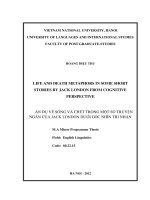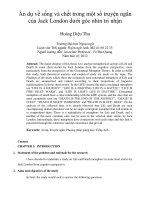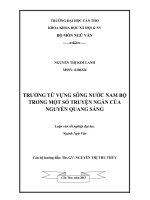Ẩn dụ về sống và chết trong một số truyện ngắn của Jack London dưới góc nhìn tri nhận
Bạn đang xem bản rút gọn của tài liệu. Xem và tải ngay bản đầy đủ của tài liệu tại đây (208.55 KB, 8 trang )
Ẩn dụ về sống và chết trong một số truyện ngắn
của Jack London dưới góc nhìn tri nhận
Hoàng Diệu Thu
Trường Đại học Ngoại ngữ
Luận văn ThS ngành: Ngôn ngữ Anh; Mã số: 60 22 15
Người hướng dẫn: Associate Professor. V Đại Quang
Năm bảo vệ: 2012
Abstract: The major purpose of this thesis is to analyze metaphorical sayings of Life and
Death in some short stories by Jack London from the cognitive perspective, more
particularly from the perspective of the Conceptual Metaphor Theory. In order to fulfill
this study, both theoretical analysis and empirical study are made on the topic. The
Findings of the study which show the commonly seen conceptual metaphors of Life and
Death are summarized and ranked according to their proportions of linguistic
manifestations in those short stories. In the LIFE system, the main conceptual metaphors
are “LIFE IS A JOURNEY”, “LIFE IS A FIGHTING/ LIFE IS A BATTLE”, “LIFE IS
FIRE/ HEAT/ WARM”, and “LIFE IS LIGHT/ LIFE IS DAYTIME”. Conceptual
metaphors of death have a close relationship with the LIFE system, and the ones that are
most commonly seen are “DEATH IS THE END OF THE JOURNEY”, “DEATH IS
COLD”, “DEATH IS NIGHT/ DARKNESS” and “DEATH IS SLEEP / REST”. On the
analysis of the collected data, it is clearly observed that Life and Death are such
encompassing matters that there can be no single conceptual metaphor that will enable us
to comprehend them. There is a multiplicity of metaphors for Life and Death, and a
number of the most common ones can be seen in the selected short stories by Jack
London. Interestingly, these metaphors have connections with each other and this link is
presented through the coherence and the consistence that prevail.
Keywords: Ẩn dụ; Truyện ngắn; Phương pháp giảng dạy; Tiếng Anh
Content
CHAPTER 1: INTRODUCTION
1. Statement of the problem and rationale for the research
I have decided to undertake a study on Life and Death metaphors in some short stories by
Jack London from cognitive perspective.
2. Aims and objectives of the study
In brief, the study would seek to answer the following questions:
- What are the common types of metaphors for the Life and Death image in Jack London’s short
stories seen from the cognitive perspective?
- What are the markers of coherence and consistence of Life and Death metaphors based on the
framework advocated by Lakoff & Johnson?
- What are the possible implications for language teaching and learning?
3. Methods of the study
The major methods which are used for conducting the research are documentary analysis and
observation. The task for the researcher is not to take such documents at face value, but to find
out how they were constructed, and how they are used and interpreted. This is why the researcher
has to take observation as one of the favored approaches. Here, the researcher adopts a role as a
member of American society to get a more comprehensive perspective of life and death in
everyday language.
To conduct the research, first of all, official documents include journals and textbooks are
collected. After the process of reading and collecting data from Jack London’s short stories, the
researcher starts to analyze the image of Life and Death in terms of conceptual metaphor. The
next step is to synthesize the information analyzed in order to fit into the thesis.
4. Signification of the study
Metaphor is one of the most basic phenomena in human language. This kind of study has
significance not only for investigation into language in use, but also for the research of human
mind. Besides theoretical significance, this study also sheds light on second language teaching
and learning. This thesis aims to analyze metaphorical sayings of Life and Death from the
cognitive perspective, i.e. to view the sayings of Life and Death from the perspective of the
Conceptual Metaphor Theory. Both theoretical analysis and empirical study are conducted on the
topic.
Metaphor is one of the most basic phenomena in human language. This kind of study has
significance not only for investigation into language in use, but also for the research of human
mind. Besides theoretical significance, this study also sheds light on second language teaching
and learning. This thesis aims to analyze metaphorical sayings of Life and Death from the
cognitive perspective, i.e. to view the sayings of Life and Death from the perspective of the
Conceptual Metaphor Theory. Both theoretical analysis and empirical study are conducted on the
topic.
CHAPTER 2: LITERATURE REVIEW
This chapter has provided a brief overview of different metaphor theories with the focus on the
theory employed as the basis for this research: the theory of conceptual metaphor introduced in
the work “Metaphor We Live By” by Lakoff & Johnson (1980).
From such reviewing, a working definition of metaphor can be obtained for this thesis.
Moreover, in order to get deeper view of conceptual metaphors, some outstanding studies that
are related to the topic of the present paper are presented at the end of the chapter.
1. Overview of different theories on metaphor
2. Conceptual metaphor
2.1. What is meant by “conceptual metaphor”?
2.2. How metaphor structures our thoughts
2.3. Mapping as a major function of metaphors
3. Highlighting and Hiding
4. Coherence and Consistence
5. Previous studies related to the theme of this thesis
CHAPTER 3: METHODOLOGY
In this chapter the two main methodological points haven been presented. (i) The major
principles governing the research. (ii) The main methods employed for the research which
includes collections instrument, data analysis techniques and data analysis procedure.
1. Principles governing the research
1.1. Principles governing the research type
This is a qualitative study which is intended to provide an overview of the conceptual metaphors
used in Jack London’s short stories about Life and Death.
1.2. Principles for the formulation of research questions
The researcher approaches the first question by looking at the metaphors of Life and Death in the
selected short stories in order to gain an understanding of the variety of the metaphors used by
Jack London.
The researcher approaches the conclusion on the first research question from the point of view of
the mapping for conceptual metaphor which was held by Lakoff and Kövecses (2003: 84) that all
of the image-schematic structure of the source that is consistent with the target is mapped onto
the target.
Finally, the purpose of this study is never to find every single metaphor of Life and death – or
something that can be counted separately – within these selected short stories, but instead to gain
a general understanding of the use of these metaphor in literature and then to find out the
possible implication for English language teaching and learning.
2. Methods employed for the research
2.1 Data collections instruments
Reading and reviewing documents are the major ways to collect materials for the research.
2.2. Data analysis techniques
Firstly, the researcher starts to analyze the image of Life and Death in terms of conceptual
metaphor. After that, the information is synthesized. The stage of analyzing and synthesizing are
all conducted manually.
2.3. Data analysis procedure
The study begins with a presentation of the theoretical background, namely the theory of
conceptual metaphor as formulated by Lakoff and Johnson (1980) and Lakoff and Turner (1989),
and for the purpose of the study, the researcher collects data through reading short stories by
Jack London. While reading these references, an action of selecting relevant information is taken
simultaneously. After the data is collected, the researcher starts analyzing and classifying the
data into the suitable categories of the thesis purpose. After that, the researcher synthesizes all
the metaphors to come the conclusion on the first research question by drawing image-schematic
structures of the sources which are mapped onto the target domain from the point of view by
Lakoff and Kövecses. To find the connection between Life and Death in terms of cognitive
perspective, the researcher try to interpret the possibility of forming a single image or just being
subcategories of a major metaphor of the mapping which are found in the first research question
based on Lakoff’s view.
CHAPTER 4: RESULTS AND FINDINGS
This chapter has showed that Life and Death metaphors are very popular with variety of
expressions. Among these expression, four major conceptual metaphors for life and four
conceptual for death which are notable in Jack London’s works are LIFE IS A JOURNEY, LIFE
IS A FIGHTING/ BATTLE, LIFE IS LIGHT/ DAYTIME, LIFE IS LIGHT, DEATH IS THE
END OF THE JOURNEY, DEATH IS COLD, DEATH IS DARKNESS, and DEATH IS REST/
SLEEP.
For having mapped onto the same target structure and having the same grounding in everyday
experience or common knowledge, the metaphors DEATH IS COLD, DEATH IS DARKNESS,
and DEATH IS REST/ SLEEP are coherent with each other. For Life metaphor, LIFE IS IS
LIGHT is coherent with the metaphor LIFE IS FIRE.
Because the Life and Death guides us in making sense of a common image – THE JOURNEY,
two conceptual metaphors LIFE IS A JOURNEY and DEATH IS THE END OF THE
JOURNEY are consistent.
CHAPTER 5: CONCLUSION
In this last chapter, the findings of the study will be summarized first and followed by
some suggestions for teaching English. This chapter also discusses the limitations of the study as
well as some recommendations for further research.
1. Concluding remarks on objective 1 – The common type of metaphor for Life and Death
image in Jack London’s short stories
It can be seen that there are four conceptual metaphors for Life known as LIFE IS A JOURNEY,
LIFE IS A FIGHTING/ BATTLE, LIFE IS LIGHT/ DAYTIME, LIFE IS LIGHT. Among the
four conceptual metaphor for Life, the mapping LIFE IS A JOURNEY and LIFE IS A
FIGHTING/ BATTLE seem to be the most popular ones with the density of sentences which are
related to these metaphors in the short stories taken into consideration.
The image of Death also evokes four senses of metaphor namely DEATH IS THE END OF THE
JOURNEY, DEATH IS REST/ SLEEP, DEATH IS COLD, and DEATH IS DARKNESS.
2. Concluding remarks on objective 2 – The markers of coherence and consistence between
the Life and Death metaphors
For having mapped onto the same target structure and having the same grounding in everyday
experience or common knowledge, the metaphors DEATH IS COLD, DEATH IS DARKNESS,
and DEATH IS REST/ SLEEP are coherent with each other. For Life metaphor, LIFE IS IS
LIGHT is coherent with the metaphor LIFE IS FIRE.
3. Concluding remarks on objective 3 - The possible implications for English language
teaching and learning
First of all, the identification and charting of universal metaphors has the potential to shed light
onto some fundamental aspect of our cognitive functions and our human existence at large. Thus,
metaphor studies should be an area of inquiry for researchers in a variety of areas, including
linguistics, anthropology, history and the cognitive sciences.
In teaching literature, regarding the importance of literature and metaphor in creating language,
the teacher should notice of the guidance for students to realize how to explore conceptual
metaphors to understand those concepts, how they are mapped and what meaning they carry on.
4. Limitations and Suggestions for further studies
Although the study has done, it is unavoidable that there are some limitations of the
research due to the limited scope, the time constraint and other objective factors.
There are still more conceptual metaphors for love, happiness, sadness and fear that
should be investigated in further researches. Moreover a cross-cultural study of conceptual
metaphors should be investigated more.
References
1. Deignan, Alice (2005). Metaphor and Corpus Linguistics. Amsterdam: John Benjamins
Publishing Company, pp.2
2. Goatly, A. (2011). The language of metaphors, Routledge, London, pp. 109
3. Hurtado, (2011). A cognitive approach to life and death in the poetry of Seamus Heaney
and Robert Frost. Unpublished master's thesis. Universidad Rey Juan Carlos.
4. Kövesces, Zoltán (2002). Metaphor: A Practical Introduction. Oxford: Oxford University
Press, pp. 6
5. Kovecses, Z. (2003). "Language, Figurative Thought, and Cross-Cultural Comparison",
Metaphor and symbol, vol. 18, no. 4, pp. 311 – 312.
6. Kövecses, Z. (2003). "The scope of metaphor" in Metaphor and metonymy at the
crossroads: a cognitive perspective, ed. A. Barcelona, Mouton de Gruyter, Berlin. Pp. 82,
84.
7. Lakoff, George and Mark Johnson (1980). Metaphors We Live By. Chicago: University
of Chicago Press, pp. 4, 15.
8. Lakoff, George and Mark Turner (1989). More Than Cool Reason: A Field Guide to
Poetic Metaphor. Chicago: University of Chicago Press, pp. 50.
9. Lakoff, G. (1993) ‘The contemporary theory of metaphor’, in Ortony, A (ed.) Metaphor
and Thought, Cambridge University Press, Cambridge. (2nd ed.), pp. 208.
10. Lakoff, G. & Johnson, M. (2003), Metaphors we live by, [New ed.] edn, University of
Chicago Press, Chicago, pp. 6, 8, 14, 33, 35.
11. NGUYEN, T. (2011), An investigation into linguistic features of conceptual metaphors in
English and Vietnamese. Unpublished master's thesis. Danang University.
12. Richardt, S. (2005), Metaphor in languages for special purposes: the function of
conceptual metaphor in written expert language and expert-lay communication in the
domains of economics, medicine and computing, Peter Lang, Frankfurt am Main, pp. 48.
13. Ruiz, J. (2007). Linguistics, and cognition: Death metaphor in fairy tales. Unpublished
master's thesis. University of La Rioja.
14. Sánchez, R. (2007). Imaginative Use of the Metaphorical Concept ‘Life is a Journey’ in
Dobyns’ Body Traffic: the Creation of the Novel Imaginative Metaphor ‘the Body is a
Vehicle’. Unpublished master's thesis. University of Granada, Spain.
15. Semino, E & Steen, G.J. (2008). Metaphor in literature. In R.W. Gibbs, jr (Ed.). The
Cambridge handbook of metaphor and thought. Cambridge: Cambridge University Press,
pp. 233.
WEBSITES AS SOURCE FOR THE DATA OBTAINED IN THE THESIS
1.
2.
3.









